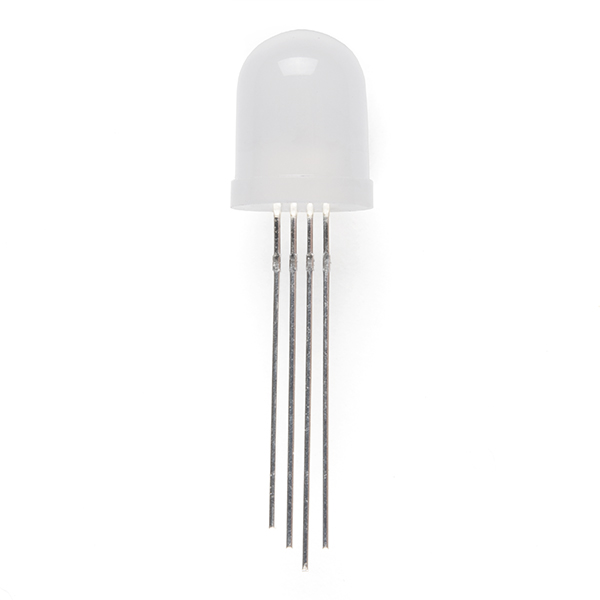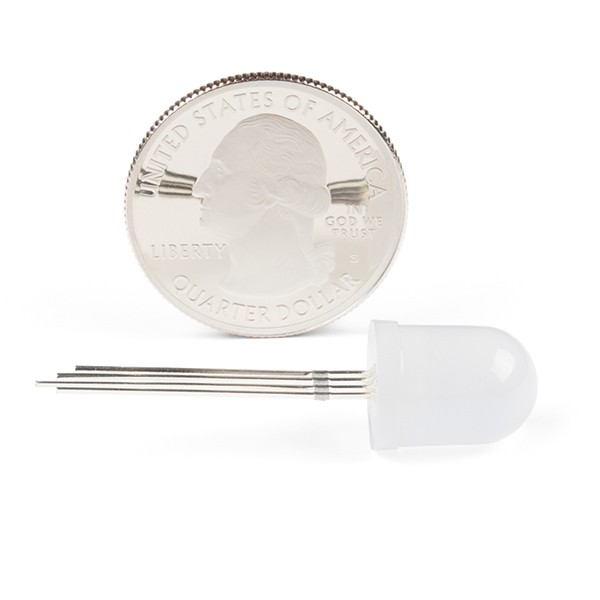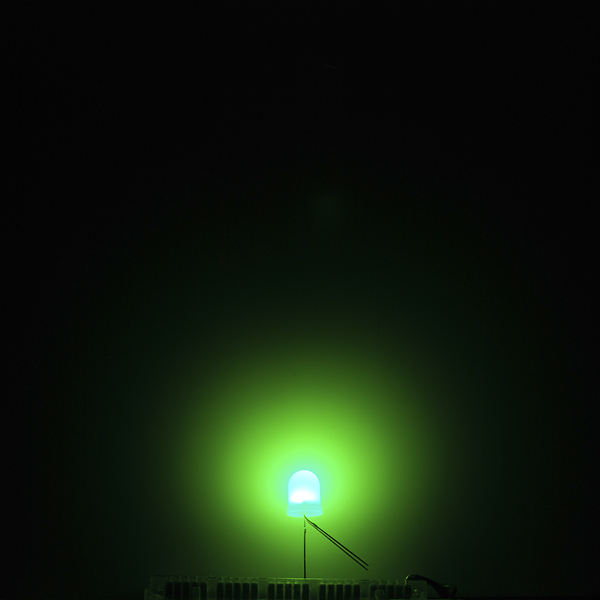Check out these big 10mm common cathode through-hole LEDs! The opaque epoxy package causes these LEDs to have a soft, diffuse glow.
- Forward Voltage (R/G/B): 2.0 / 3.2 / 3.1V
- Forward Current: 20mA
- Intensity (R/G/B): 550 / 250 / 700 mcd
- Common Cathode
Diffused LED - RGB 10mm Product Help and Resources
Non-Addressable RGB LED Strip Hookup Guide
February 19, 2020
Add color to your projects with non-addressable LED strips! These are perfect if you want to control and power the entire strip with one color for your props, car, fish tank, room, wall, or perhaps under cabinet lighting in your home.
Core Skill: Electrical Prototyping
If it requires power, you need to know how much, what all the pins do, and how to hook it up. You may need to reference datasheets, schematics, and know the ins and outs of electronics.
Skill Level: Rookie - You may be required to know a bit more about the component, such as orientation, or how to hook it up, in addition to power requirements. You will need to understand polarized components.
See all skill levels
Comments
Looking for answers to technical questions?
We welcome your comments and suggestions below. However, if you are looking for solutions to technical questions please see our Technical Assistance page.
Customer Reviews
4.5 out of 5
Based on 2 ratings:
1 of 1 found this helpful:
Good starting point.
I was all for RGB LEDs. Then I built a project using almost 100 RGB's. Go addressable and get there quickly. There may be a little learning curve but well worth it. Yes they are more expensive, but I have learned that almost every time I work on a project I wish I could scale the project.
Conclusion: Well worth it to get a few to tinker with initially or for specific needs, such as a single indicator light on a project.
2 of 2 found this helpful:
Excellent Colours
The opaque coating gives much better colour blending than I expected — at least, better than a 50-pack of 5mm RGBs for the same price. It took some fudging around with different resistors, but I found a combination that gives excellent yellow, magenta, cyan and white.
Bit pricey, but totally worth it. I'm definitely planning on buying more of these. LOTS more. >:D
Helpful notes/observations: - Common cathode = connect the longest pin to ground, put resistors on other pins - For equal perceived brightness (and a really good white mix), I used: R-100Ω, G-220Ω, B-150Ω. (Off 3.3V from a Teensy/YwRobot supply). - At the same brightness, the red uses far more current (14 mA vs. 3.5 for green and blue, using the above resistors)






Does anybody know how/if these could be through hole mounted to a PCB. I bought a few of them without really thinking this through, and now that I'm looking at the pictures a bit closer it seems like perhaps the pins are too close for mounting on a PCB?
Any advice / thoughts?
p.s. I'm new to PCB design
Hi! Sure, you can mount these to a PCB. The holes are closer together than 1/10" though so you need to space the holes closer together if you want the LED mounted flush to the board. If you're OK with the LED being 1/4 to 1/2 of an inch above the surface of the board, regular 1/10" spacing would be OK.
Is this common anode or common cathode? Can that be added to the product description, thanks!
Common cathode, it says so right on the data sheet. RTFM.
I read the data sheet three times and it does not say in text the configuration. Just realized I had to install the chineese language pack to see the schematic image.
Well then I apologize. I had to install the Chinese language pack a while back. I didn't even think about that.
I made a nice little color changing light with this, if you just got one and you want to see lots and lots of colors, try this code.
If you shorten the delays to 1 millisecond and you add another 1000 millisecond delay after every while loop you'll get a nice pause effect. :)
I will gladly take 10 of these beauties!
These are very nice. They are common cathode devices. With the diffused case and depending on which colors (RGB) are turned on, one can get eight different colors. For good color balance the current limiting resistors need to be different. For a 5 volt supply, I found using a 330 ohm for red, 510 ohm for green and 270 ohm for blue gave reasonable colors for cyan, magenta, and white. The eighth color is black with all leds off. They can be used to show how the properties of color addition.
I connected these directly to my arduino's analog pins and scaled down my analogWrite maximum based on each led's typical forward voltage. The safe ranges turn out to be R: 0-102, G: 0-163, B: 0-158 (using forwardVolage/5 * 255). No Resistors needed!
LED addict, thanks for the code. Used as my 'Blink', first upload to an arduino. Works great and helped me figure out how to code my own.
Can you provide this 10mm RGB LED as a super bright with clear epoxy?
Can anyone provide the exact pin pitch on these?
In case anyone else is laying out a circuit board, I measured the pin pitch at 0,05" The pins are 0.02" diameter. Contrary to the datasheet, there is no noticeable flat side of the package, you will have to orient them using the pins lengths.
I'm having trouble getting the green element to work. With a 5V Arduino PWM output, I'm using a 100 ohm resistor for green, 100 for blue and 220 for red. It worked at initially for a short time, but it doesn't light anymore no matter what I try. I'm having the same problem with two different ones of these, but I have no idea whether I'm doing something wrong.
Your resistor values are fine. Green forward voltage drop is 3.2V so (5 V-3.2 V)/100 Ohms equals 18mA which is less than the rated value of 20mA. You may have gotten a defective part or your resistor failed. Both of these happen sometimes (or even your Arduino PWM port failed. That has happened to me recently. You can try swapping connections to troubleshoot that.
Thanks. Sparkfun sent out replacements, and everything works fine now!
Just FYI (For Your Information): You need 3 resistors to get it working smoothly when driving it with PWM from an arduino, one for each color. Putting just one resistor between the LED and GND gives a strange flickering.
Someone else could probably tell more about why this is happening. I think it has something to do with the dropout voltage differing on the different colors.
I must say, these are beautiful LEDs. I got one on my last order, but I think I'll get 10 more next time.